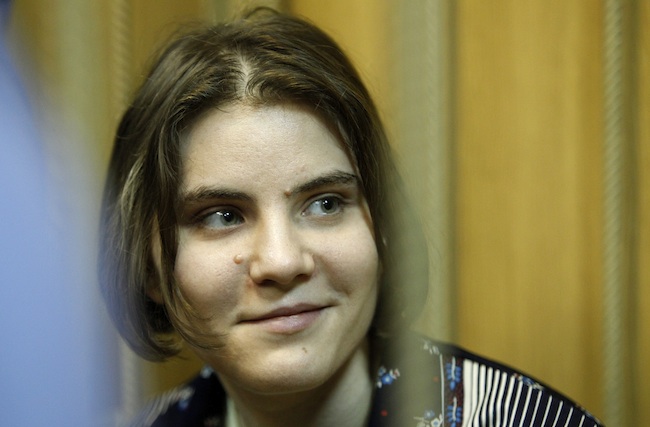Pussy Riot explain why they used the Church
 WHY did Pussy Riot use the Church to stage their ‘punk prayer’ protest? Pussy Riot member Yekaterina Samutsevich is now serving a two-year sentence for exposing Vladimir Putin.
WHY did Pussy Riot use the Church to stage their ‘punk prayer’ protest? Pussy Riot member Yekaterina Samutsevich is now serving a two-year sentence for exposing Vladimir Putin.
This was her closing statement in court:
The fact that Christ the Savior Cathedral had become a significant symbol in the political strategy of our powers that be was already clear to many thinking people when Vladimir Putin’s former [KGB] colleague Kirill Gundyaev took over as head of the Russian Orthodox Church. After this happened, Christ the Savior Cathedral began to be used openly as a flashy setting for the politics of the security services, which are the main source of power [in Russia].
Why did Putin feel the need to exploit the Orthodox religion and its aesthetics? After all, he could have employed his own, far more secular tools of power—for example, national corporations, or his menacing police system, or his own obedient judiciary system. It may be that the tough, failed policies of Putin’s government, the incident with the submarine Kursk, the bombings of civilians in broad daylight, and other unpleasant moments in his political career forced him to ponder the fact that it was high time to resign; otherwise, the citizens of Russia would help him do this. Apparently, it was then that he felt the need for more convincing, transcendental guarantees of his long tenure at the helm. It was here that the need arose to make use of the aesthetics of the Orthodox religion, historically associated with the heyday of Imperial Russia, where power came not from earthly manifestations such as democratic elections and civil society, but from God Himself.
How did he succeed in doing this? After all, we still have a secular state, and shouldn’t any intersection of the religious and political spheres be dealt with severely by our vigilant and critically minded society? Here, apparently, the authorities took advantage of a certain deficit of Orthodox aesthetics in Soviet times, when the Orthodox religion had the aura of a lost history, of something crushed and damaged by the Soviet totalitarian regime, and was thus an opposition culture. The authorities decided to appropriate this historical effect of loss and present their new political project to restore Russia’s lost spiritual values, a project which has little to do with a genuine concern for preservation of Russian Orthodoxy’s history and culture.
It was also fairly logical that the Russian Orthodox Church, which has long had a mystical connection with power, emerged as this project’s principal executor in the media. Moreover, it was also agreed that the Russian Orthodox Church, unlike the Soviet era, when the church opposed, above all, the crudeness of the authorities towards history itself, should also confront all baleful manifestations of contemporary mass culture, with its concept of diversity and tolerance.
Posted: 18th, August 2012 | In: Reviews Comment | TrackBack | Permalink


